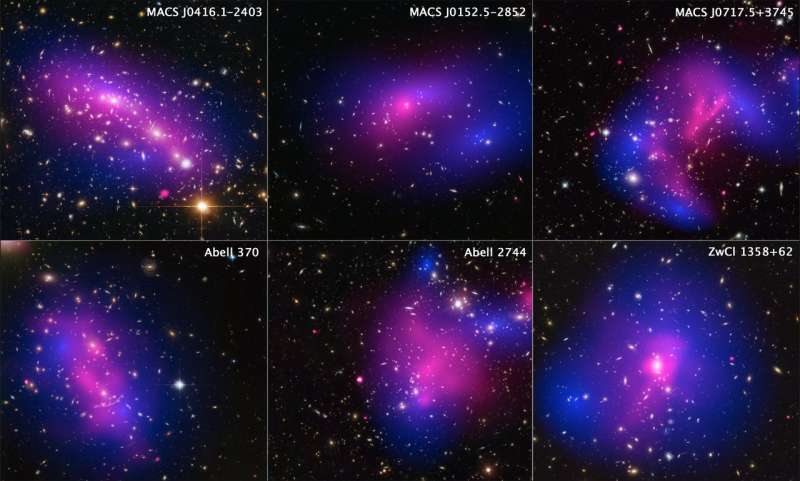The search for dark matter—axions have ever-fewer places to hide

If they exist, axions, among the candidates for dark matter particles, could interact with the matter comprising the universe, but at a much weaker extent than previously theorized. New, rigorous constraints on the properties of axions have been proposed by an international team of scientists.
The latest analysis of measurements of the electrical properties of ultracold neutrons, published in the scientific journal Physical Review X, has led to surprising conclusions. On the basis of data collected in the Electric Dipole Moment of Neutron (nEDM) experiment, an international group of physicists demonstrated that axions, hypothetical particles that may comprise cold dark matter, would have to comply with much stricter limitations than previously believed with regard to their mass and manners of interacting with ordinary matter. The results are the first laboratory data imposing limits on the potential interactions of axions with nucleons (i.e. protons or neutrons) and gluons (the particles bonding quarks in nucleons).
"Measurements of the electric dipole moment of neutrons have been conducted by our international group for a good dozen or so years. For most of this time, none of us suspected that any traces associated with potential particles of dark matter might be hidden in the collected data. Only recently, theoreticians have suggested such a possibility and we eagerly took the opportunity to verify the hypotheses about the properties of axions," says Dr. Adam Kozela (IFJ PAN), one of the participants in the experiment.
Dark matter was first proposed to explain the movements of stars within galaxies and galaxies within galactic clusters. The pioneer of statistical research on star movements was the Polish astronomer Marian Kowalski. In 1859, he noticed that the movements of nearby stars could not be explained solely by the movement of the sun. This was the first observational evidence suggesting the rotation of the Milky Way. Kowalski is thus the man who "shook the foundations" of the galaxy. In 1933, the Swiss astronomer Fritz Zwicky went one step further. He analyzed the movements of structures in the Coma galaxy cluster using several methods. He then noticed that they moved as if there were a much larger amount of matter in their surroundings than that observed by astronomers.
Astronomers believe there should be almost 5.5 times as much dark matter in the universe as ordinary matter, as background microwave radiation measurements suggest. But the nature of dark matter is still unknown. Theoreticians have constructed many models predicting the existence of particles that are more or less exotic, which may account for dark matter. Among the candidates are axions. These extremely light particles would interact with ordinary matter almost exclusively via gravity. Current models predict that in certain situations, a photon could change into an axion, and after some time, transform back into a photon. This hypothetical phenomenon is the basis of the famous "lighting through a wall" experiments. These involve directing an intense beam of laser light onto a thick obstacle, and observing those photons that change into axions that penetrate the wall. After passing through, some of the axions could become photons again, with features exactly like those originally directed at the barrier.
Experiments related to measuring the electric dipole moment of neutrons have nothing to do with photons. In experiments conducted for over 10 years, scientists measured changes in the frequency of nuclear magnetic resonance (NMR) of neutrons and mercury atoms in a vacuum chamber in the presence of electric, magnetic and gravitational fields. These measurements enabled the researchers to draw conclusions about the precession of neutrons and mercury atoms, and consequently on their dipole moments.
Theoretical works have appeared in recent years that envisage the possibility of axions interacting with gluons and nucleons. Depending on the mass of the axions, these interactions could result in smaller or larger disturbances with the character of oscillations of dipole electrical moments of nucleons, or even whole atoms. The predictions meant that experiments conducted as part of the nEDM cooperation could contain valuable information about the existence and properties of potential particles of dark matter.
"In the data from the experiments at PSI, our colleagues conducting the analysis looked for frequency changes with periods in the order of minutes, and in the results from ILL—in the order of days. The latter would appear if there was an axion wind, that is, if the axions in the near Earth space were moving in a specific direction. Since the Earth is spinning, at different times of the day our measuring equipment would change its orientation relative to the axion wind, and this should result in cyclical, daily changes in the oscillations recorded by us," explains Dr. Kozela.
The results of the search turned out to be negative. No trace of the existence of axions with masses between 10-24 and 10-17 electron volts were found (for comparison: the mass of an electron is more than half a million electron volts). In addition, the scientists managed to tighten the constraints imposed by theory on the interaction of axions with nucleons by 40 times. In the case of potential interactions with gluons, the restrictions have increased more than 1000-fold. So if axions do exist, in the current theoretical models, they have fewer places to hide.
More information: C. Abel et al, Search for Axionlike Dark Matter through Nuclear Spin Precession in Electric and Magnetic Fields, Physical Review X (2017). DOI: 10.1103/PhysRevX.7.041034
Journal information: Physical Review X
Provided by The Henryk Niewodniczanski Institute of Nuclear Physics Polish Academy of Sciences



















